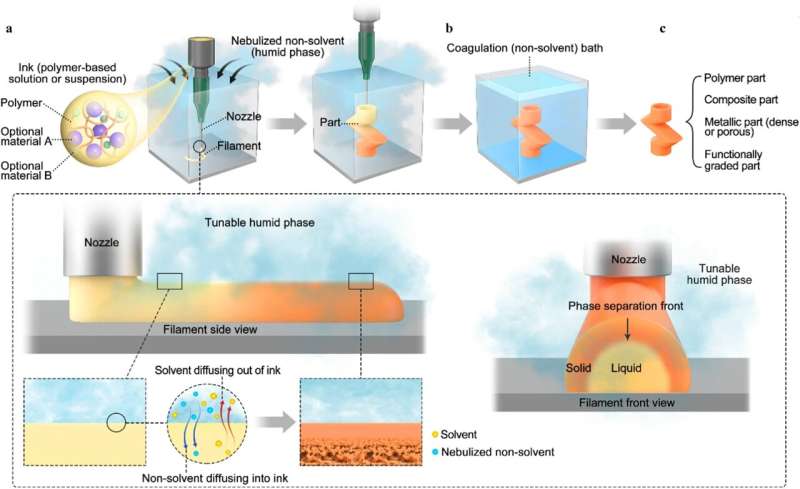
University of Florida engineers have developed a method for 3D printing called vapor-induced phase-separation 3D printing, or VIPS-3DP, to create single-material as well as multi-material objects. The discovery has the potential to advance the world of additive manufacturing.
Yong Huang, Ph. D., a professor in UF's department of mechanical and aerospace engineering, said the printing process he and colleagues developed allows manufacturers to create custom-made objects economically and sustainably. The novel approach is reported in the journal Nature Communications.
"It is more economical and much simpler than current counterpart technologies," he said. "It's an affordable process for printing advanced materials, including metals."
To understand the process, imagine using special eco-friendly liquids to make the "ink" for a 3D printer. These dissolvable polymer-based liquids can include metal or ceramic particles. When you print with this ink, a non-solvent vapor is released into the printing area. This vapor makes the liquid part of the ink solidify, leaving behind the solid material—called the vapor-induced phase-separation process.
Huang explained the process allows manufacturers to 3D print multi-material parts with spatially tunable, multi-scale porosity, which means creating structures that have different kinds of substances at different locations and with varied levels of porousness.
The object's porousness refers to it having tiny holes or gaps, and this is created by adjusting printing conditions and/or how much sacrificial material is used during the VIPS-3DP process. This can be useful for manufacturing things like porous medical implants or lightweight aerospace products.
"This is a promising method for creating metallic products that require different levels of porousness," said Marc Sole-Gras, Ph.D., the first author of the paper and a former graduate student in Huang's lab. "A good example of this is in bone tissue engineering. We can print an implant that is appropriately porous to ensure it integrates with the surrounding human cells."
In addition to requiring less investments in infrastructure, the VIPS-3DP process is a greener option to traditional printing methods because it uses sustainable materials and less energy.
More information: Marc Sole-Gras et al, Vapor-induced phase-separation-enabled versatile direct ink writing, Nature Communications (2024). DOI: 10.1038/s41467-024-47452-9
Citation: New 3D-printing method makes printing objects more affordable and eco-friendly (2024, April 10) retrieved 10 April 2024 from https://techxplore.com/news/2024-04-3d-method-eco-friendly.html
This document is subject to copyright. Apart from any fair dealing for the purpose of private study or research, no part may be reproduced without the written permission. The content is provided for information purposes only.
